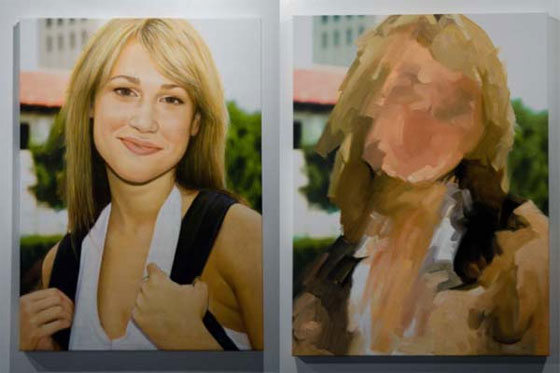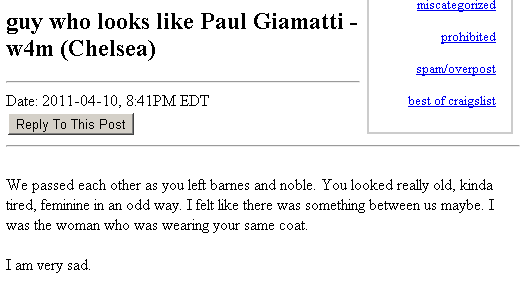
Parker Ito, The Most Infamous Girl in the History of the Internet by Parker Ito, 2010- ????
- Is net art insular and plagued by sameness? Nicholas O’Brien thinks so, but notes that jstchillin’s Read/Write show at 319 Scholes last month fared better than most in avoiding self-referential art. If we’re counting heads, I’d agree with that statement, though as a net professional it’s not surprising that works like say, Parker Ito’s painting The Most Infamous Girl in the History of the Internet by Parker Ito, 2010, stood out regardless of merit. I’m already intimately familiar with the image — it’s commonly found on parked domains — so it remains one of the more dominant images in the show for me after the fact. A better-curated effort might have worked to level that relationship a little more, either through the selection of work or its arrangement.
- Making the Internet rounds is Gene McHugh’s a-z biography on artist Tom Moody on Post Internet. It’s a pretty fantastic post and at the very least should give the Wiki thralls quite a bit to update on Moody’s entry.
- Digital Folklore: A Conversation With Olia Lialina and Dragon Espenschied tonight at The New Museum. I’ve been looking forward to this conversation for MONTHS. Lialina is responsible for what are, in my opinion, the best series of essays on web aesthetics to date: Web Vernacular 1, Web Vernacular 2, and Web Vernacular 3. Together with partner Dragon Espenschied, she published a series of essays in an anthology titled Digital Folklore. The talk will examine how folk lore is defined in the digital age: that made by the amateurs and on a computer.
- In Rhizome news, next Thursday, April 21, I will be attending their annual Spring Benefit and I hope you will too. Rhizome does a lot of work to support the New Media community so it’s important to give back during these times. This year Rhizome will honor their founder, Mark Tribe.
- In other Rhizome news, the Tomorrow Museum’s Joanne McNeil will be taking over as their Senior Editor this May. I’m not exactly the most unbiased source, but having been roommates with McNeil for the past year I’m very excited about this. She’s a great blogger with a focus on art, literature, and technology. It’s a rare combination and one I’m sure will serve Rhizome well.
- Finally, Speaking of Rhizome: remember Seven on Seven, the one day conference that paired artists with technologists and asked them to make art? The boot camp is back! I thought last year was a great success. Here’s hoping for a repeat.
- This week at The New York Times Magazine: Five million stories about normal shit that can kill a person. Is sitting a lethal activity? Is sugar toxic? Do cellphones cause brain cancer? This would have been a perfect issue to revisit the Writers Blog Till They Drop story of 2008. Writing KILLS! Also, where is the link to Kill or Cure, the website that tracks stories about stuff that’s bad for you? A favorite: babies! They both cause and prevent cancer.
- In an aesthetics-related story at The Times, Steven Stern pens Meat Discovered in Meatless Magazines, a dining section post about a recent uproar over trade rag Veg News’s decision to use of stock photographs of actual meat as opposed to the fake stuff. “That picture of a burger? It’s actually a burger,” writes Stern. Lead uproarer Quarrygirl promises to cancel her subscription to the mag and return her 2009 Scandal Breaker of the Year Award. In a related story, the United States Postal Service has issued a new stamp with the Statue of Liberty on it, unknowingly using an image of the replica of Ms. Liberty at The New York New York Casino in Las Vegas.
- Finally, this gem:



{ 7 comments }
“I was the woman who was wearing your same coat.” What a sad, strange city.
I got pleasure out of seeing her image defaced… is that wrong?
I often forget that Parker Ito did not make that image. The crazy smudgings also convey simulated handwork in the image on the right… so “if the hand is dead” according to him, redundant references to it isn’t.
http://www.youtube.com/watch?v=_6woN7WINr4
The “parked domain girl” was already an iconic bad Net image before she was painted (badly). I’ve never understood the need for this to be a painting subject. (Maybe if she was painted well…)
Thanks for the shout on the McHugh bio.
An earlier, funnier reference to the parked domain girl was when Guthrie Lonergan spotted her on the Brown college website ( http://www.tommoody.us/archives/2009/11/16/pdg-sighting/ )
She was declared “most infamous” in 2008: http://yousuckatwebsites.com/web-trends/the-most-infamous-girl-in-the-history-of-the-internet
In view of all that, I didn’t understand John Michael Boling putting the crappy painted version on the Rhizome.org front page in 2010 ( http://rhizome.org/editorial/2010/mar/25/the-most-infamous-girl-in-the-history-of-the-inter/#c63944 ) or why we’re still talking about it.
That Guthrie find is hilarious.
I like that You Suck went to the trouble of trying to identify the background. I’m not sure I buy that she’s a University of Texas student, but the post at least adds a little to the photograph.
In Ito’s case I think very little is gained by painting the image. The image is free and highly circulated, and sending it to China increases the value of materials. If he’s lucky the value of the object will increase as well. But what is the point of these actions? Is the point simply that’s there’s none?
As for the argument a good painting would make, there are one or two people a century who can pull that off. It’s not Ito.
Comments on this entry are closed.